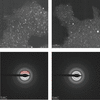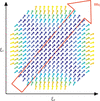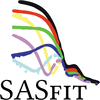issue contents
December 2022 issue

Cover illustration: Magnetic force microscopy imaging of magnetic domain patterns at the surface of bulk (Fe0.63Ni0.30Pd0.07)3P at room temperature [Karube et al. (2022). J. Appl. Cryst. 55, 1392–1400] .
research papers
The anisotropic fractal magnetic domain structure in bulk single-crystal (Fe0.63Ni0.30Pd0.07)3P has been quantitatively characterized using small-angle neutron scattering.
Partitioning of small amphiphilic molecules into biomembranes and other lamellar structures induces structural changes and impacts the properties of the membrane. This work presents a model to describe the amount of co-solvent within the bilayer, its localization and the induced changes to the bilayer structure. The implementation of this model is shared as a fitting algorithm within SasView.
Quantitative microstructural characterization of different nanocrystalline materials based on Rietveld refinement of electron diffraction patterns is presented to demonstrate the application of the methodology described in Part I [Sinha et al. (2022). J. Appl. Cryst. 55, 953–965].
Open  access
access
 access
accessA modulation of intensity with zero effort (MIEZE) setup is proposed for high-resolution neutron spectroscopy at momentum transfers up to 3 Å−1, energy transfers up to 20 meV and an energy resolution in the microelectronvolt range using both thermal and cold neutrons.
Crystallographic texture measurement strategies have been developed and tested at two recently upgraded beamlines at the High Flux Isotope Reactor, Oak Ridge National Laboratory: WAND2 and HIDRA.
This study establishes the structure–property correlation that eases the initial optimization process for various alkaline-earth-metal-based perovskites.
The nature of the observed bulk inhomogeneities in the silicon layers in W/Si multilayers is established. In the diffuse scattering spectra, specific substructures, which are clearly resonant in nature, are observed. The physical nature of some of them is not established.
A high-resolution synchrotron X-ray diffraction study of a YCrO3 single crystal has allowed the structural parameters of the noncentrosymmetric P1211 space group to be obtained. The pathway of spin interactions was found for the formation of antiferromagnetism in YCrO3. Ferroelectricity in YCrO3 may originate from the strain-balanced Cr1—O3(O4) and Cr2—O5(O6) bonds and the local distortion modes of CrO6 octahedra in the P1211 space group. The relationship between microscopic and macroscopic properties has been revealed.
Open  access
access
 access
accessThe magnetization profile and the ensuing magnetic neutron scattering signal from an inhomogeneously magnetized spherical nanoparticle with Néel surface anisotropy are derived analytically.
Open  access
access
 access
accessBased on the Landau–Lifshitz equation, atomistic simulations of the magnetic neutron scattering from inhomogeneously magnetized spherical nanoparticles with a strong surface anisotropy are carried out.
The observation of neutron interference using a split-crystal interferometer opens the way to realizing interferometers with vast arm separation and length. Setting the design specifications requires a three-dimensional model of their operation. Also, the spatial coherence of the source affects the interference visibility. This paper presents a novel formalism to model crystal interferometers, operating with both coherent and partially coherent X-rays and neutrons, in three dimensions.
Open  access
access
 access
accessIn neutron scattering experiments, data sets with different statistical significance are collected. A new method is presented to efficiently calculate the weights of single-crystal time-of-flight measurements, and to add together the various contributions.
Open  access
access
 access
accessEvaluating crystal structure packings using coordinate root-mean-square deviation (RMSD) for N molecules (or N asymmetric units) in a reproducible manner requires metrics to describe the shape of the compared molecular clusters to account for alternative approaches used to prioritize selection of molecules. Described here is a fast algorithm called Progressive Alignment of Crystals (PAC) to evaluate crystal packing similarity using coordinate RMSD and introducing the radius of gyration as a metric to quantify the shape of the superimposed clusters.
The band gaps of metal–organic framework, organic and inorganic materials were assessed from X-ray powder diffraction patterns. The assessments were done with convolutional neural networks.
Open  access
access
 access
accessAttention is focused on perhaps the biggest bottleneck in data analysis for serial crystallography at X-ray free-electron lasers, which has not received serious enough examination to date. An effective and reliable way is presented to identify anomalies in detectors, using machine learning and recently developed mathematical methods in the field referred to as `robust statistics'.
Open  access
access
 access
accessThe availability of micro- and nano-X-ray beams makes measurement of scattering from very small volumes possible, opening possibilities for deriving in situ structural information on fibrillar constituents in complex materials and tissues. This work outlines a set of strategies for confronting major technical obstacles to extract useful structural information from scattering derived from these samples.
Download citation


Download citation


Open  access
access
 access
accessA method for performing accurate quantitative phase analysis using X-ray powder diffraction of pyrite concentrate mineral samples from the Thackaringa mine has been devised. The sample preparation optimization process is described. Grain size reduction suitable for analysis by the Rietveld method was achieved using ball milling.
CCDC references: 2223099; 2223100; 2223101; 2223102; 2223103; 2223104; 2223105; 2223106; 2223107; 2223108; 2223109; 2223110; 2223111; 2223112; 2223113; 2223114; 2223115; 2223116; 2223117; 2223118; 2223119; 2223120; 2223121; 2223122; 2223123; 2223124; 2223125; 2223126; 2223127; 2223128; 2223129; 2223130; 2223131; 2223132; 2223133; 2223134; 2223135; 2223136; 2223137; 2223138; 2223139; 2223140; 2223141; 2223142; 2223143
Download citation


Download citation


Open  access
access
 access
accessZero-loss energy-filtered 3D electron diffraction experiments are performed using a post-column energy filter, and both data quality and structures are improved after energy filtration. A novel crystal tracking method is developed, based on a live high-angle annular dark-field image stream. This method can track crystals to achieve high-completeness data sets without adding any additional dose or removing any frames.
CCDC references: 2210468; 2210469; 2210470; 2210471; 2210472; 2210473; 2210474; 2210475; 2210476; 2210477; 2210478; 2210479; 2210480; 2210481; 2210482; 2210483; 2210484; 2210485; 2210486; 2210487; 2210488; 2210489; 2210490; 2210491; 2210492; 2210493; 2210494; 2210495; 2210496; 2210497; 2210498; 2210499; 2210500; 2210501; 2210502; 2210503; 2210504; 2210505; 2210506; 2210507; 2210508; 2210509; 2210510; 2210511; 2210512; 2210513; 2210514; 2210515; 2210516; 2210517
Open  access
access
 access
accessSmall-angle neutron scattering and small-angle X-ray scattering are important experimental techniques for studying the behaviour and properties of materials on the nanoscale. This article describes a numerical algorithm that uses reverse Monte Carlo simulations to model scattering intensities observed on a two-dimensional small-angle scattering detector.
Open  access
access
 access
accessThis article reviews the opportunities and limitations of time-involved small-angle neutron scattering experiments, with the typical artifacts of the recorded data illustrated by virtue of the response of the skyrmion lattice in MnSi under periodic changes of the direction of the stabilizing field.
Open  access
access
 access
accessIn-field small-angle neutron scattering reveals superstructure formation in a concentrated dispersion of spherical and cuboidal iron oxide nanoparticles.
Open  access
access
 access
accessThis article presents a set of cuboidal cobalt ferrite nanoparticles with exceptionally high crystallinity, revealed by homogeneous magnetization with negligible near-surface spin disorder as observed by magnetic small-angle neutron scattering.
Open  access
access
 access
accessIn situ gas-loading sample holders for two-dimensionally arranged detectors in time-of-flight neutron total scattering experiments have been developed for the structural analysis of the deuterium absorption process using time and real-space resolution.
There is a rapidly growing trend in the application of ultra-small-angle neutron scattering (USANS) across many different fields of research, as a stand-alone technique and in combination with small-angle neutron scattering (SANS). Implementation of USANS capability on pin-hole SANS instruments was investigated using neutron ray-tracing simulations, and the design and optimization of the USANS optics are presented.
Open  access
access
 access
accessGrain reconstruction methods based on both forward and back calculations have been developed for laboratory-based diffraction contrast tomography. These methods are computationally efficient and can give good orientation and spatial accuracies, and the code is open source.
computer programs
fullrmc is an open-source framework to model and optimize atomic and molecular materials. It is enabled with reinforcement machine learning and designed to solve complex crystalline, amorphous atomic or molecular structures up to the nanoscopic scale.
Open  access
access
 access
accessRecent enhancements and additions to the SASfit program are discussed, including anisotropic scattering models, flexible distributions, regularization techniques such as the expectation-maximization method, and new structure factors, especially for ordered nano- and meso-scaled material. The Ornstein–Zernike solver for numerical structure factors is also introduced.
Open  access
access
 access
accessAn overview of the Euphonic Python package for efficient simulation of inelastic neutron scattering by phonons from force constants is presented.
book reviews
Free 


 journal menu
journal menu

















































